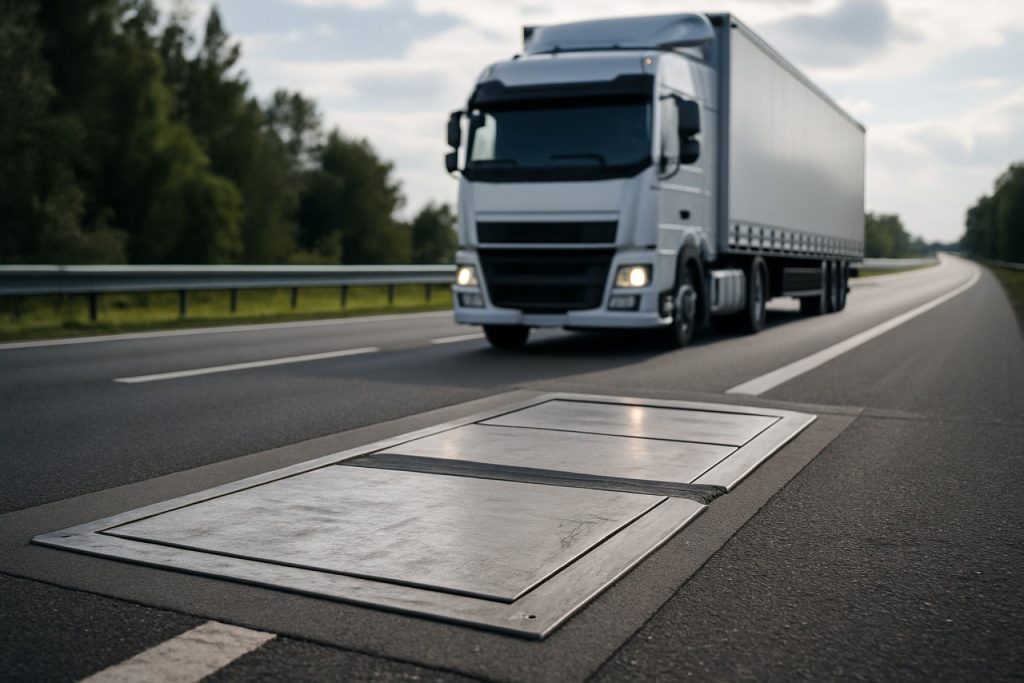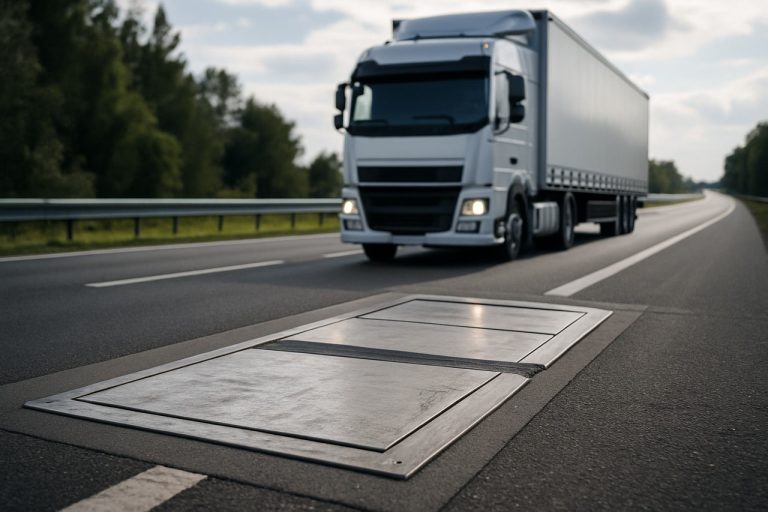
Highway Weigh-in-Motion Sensor Manufacturing in 2025: Transforming Roadway Intelligence and Compliance for a Connected Future. Explore Market Growth, Technology Shifts, and Strategic Opportunities.
- Executive Summary and Key Findings
- Market Size, Growth Rate, and 2025–2030 Forecasts
- Competitive Landscape: Leading Manufacturers and Innovators
- Emerging Technologies: AI, IoT, and Sensor Advancements
- Regulatory Drivers and Industry Standards (e.g., ASTM, AASHTO)
- Integration with Smart Infrastructure and Connected Vehicles
- Regional Analysis: North America, Europe, Asia-Pacific, and Beyond
- Key End-User Segments: Government, Toll Operators, and Logistics
- Challenges: Accuracy, Durability, and Data Security
- Future Outlook: Strategic Opportunities and Market Entry Recommendations
- Sources & References
Executive Summary and Key Findings
The highway weigh-in-motion (WIM) sensor manufacturing sector is experiencing significant momentum in 2025, driven by the global push for smarter transportation infrastructure, stricter regulatory enforcement, and the need for efficient freight management. WIM systems, which enable the dynamic measurement of vehicle weights as they travel at highway speeds, are increasingly being adopted by national and regional transportation authorities to monitor road usage, prevent overloading, and optimize maintenance schedules.
Key industry players such as Kistler Group, Teledyne FLIR, and SICK AG continue to lead innovation in sensor technology, offering piezoelectric, bending plate, and fiber optic solutions tailored for diverse roadway environments. Kistler Group, for example, is recognized for its quartz-based Lineas WIM sensors, which are widely deployed in Europe, North America, and Asia. These sensors are valued for their accuracy, durability, and ease of integration with existing traffic management systems.
In 2025, the sector is characterized by a shift toward digitalization and data connectivity. Manufacturers are embedding advanced analytics and IoT capabilities into WIM sensors, enabling real-time data transmission to centralized traffic management platforms. This trend is exemplified by SICK AG, which integrates WIM data with vehicle classification and license plate recognition for comprehensive enforcement and planning solutions. Similarly, Teledyne FLIR leverages its expertise in traffic sensing to provide multi-sensor platforms that combine WIM with video analytics.
The demand for WIM systems is further propelled by regulatory initiatives in regions such as the European Union, where the enforcement of axle load limits and the implementation of road user charging schemes are becoming more stringent. In the United States, the Federal Highway Administration continues to support the deployment of WIM technology for infrastructure protection and freight data collection. These policy drivers are expected to sustain robust growth in sensor manufacturing through 2025 and beyond.
Looking ahead, the outlook for highway WIM sensor manufacturing remains positive. The sector is poised for continued expansion as governments invest in smart roadways and as logistics operators seek to optimize fleet compliance and efficiency. Ongoing R&D efforts by leading manufacturers are likely to yield further improvements in sensor accuracy, durability, and interoperability, reinforcing the critical role of WIM technology in the future of intelligent transportation systems.
Market Size, Growth Rate, and 2025–2030 Forecasts
The global market for highway weigh-in-motion (WIM) sensor manufacturing is experiencing robust growth in 2025, driven by increasing investments in intelligent transportation systems, stricter vehicle weight regulations, and the need for efficient freight management. The market size is estimated to be in the range of several hundred million USD, with leading manufacturers reporting strong order books and expansion plans. Growth is particularly pronounced in North America, Europe, and parts of Asia-Pacific, where governments are prioritizing road safety and infrastructure longevity.
Key players in the sector include Kistler Group, a Swiss-based company recognized for its piezoelectric WIM sensors and integrated systems, and Teledyne FLIR, which offers advanced traffic monitoring and WIM solutions. Smartrac Technology and Avery Dennison are also active in sensor technology, though their focus is broader than just WIM. In the United States, International Road Dynamics (IRD), a subsidiary of Quarterhill Inc., is a prominent manufacturer and system integrator, supplying WIM systems to transportation agencies worldwide. European manufacturers such as Vector Informatics and Wavetronix (with a global presence) are also expanding their WIM product lines to meet growing demand.
The annual growth rate for the WIM sensor manufacturing market is projected to be between 7% and 10% through 2030, with the Asia-Pacific region expected to outpace other markets due to rapid infrastructure development and increased adoption of smart road technologies. The European Union’s continued enforcement of axle load regulations and the United States’ focus on freight efficiency are major drivers for sustained demand. In China and India, government-led highway modernization programs are creating new opportunities for both local and international manufacturers.
Technological advancements are shaping the competitive landscape. Manufacturers are investing in the development of more accurate, durable, and maintenance-free sensors, including fiber-optic and piezoelectric technologies. Integration with cloud-based analytics and real-time data platforms is becoming standard, as seen in offerings from Kistler Group and International Road Dynamics. These innovations are expected to further accelerate market growth by enabling predictive maintenance, automated enforcement, and seamless integration with broader intelligent transportation systems.
Looking ahead to 2030, the highway WIM sensor manufacturing market is poised for continued expansion, underpinned by regulatory trends, infrastructure investments, and the ongoing digital transformation of road transport networks. Leading manufacturers are expected to increase production capacity and invest in R&D to maintain competitiveness in this evolving landscape.
Competitive Landscape: Leading Manufacturers and Innovators
The competitive landscape of highway weigh-in-motion (WIM) sensor manufacturing in 2025 is characterized by a blend of established global leaders, regional specialists, and emerging innovators. The sector is driven by increasing demand for efficient freight monitoring, regulatory compliance, and the integration of smart transportation infrastructure. Key players are investing in advanced sensor technologies, data analytics, and system integration to maintain their market positions and address evolving customer needs.
Among the most prominent manufacturers, Kistler Group stands out as a global leader in WIM technology. Headquartered in Switzerland, Kistler is renowned for its quartz-based Lineas WIM sensors, which are widely deployed across Europe, North America, and Asia. The company continues to innovate in sensor accuracy, durability, and connectivity, supporting both permanent and temporary WIM installations. Kistler’s focus on digitalization and integration with traffic management systems positions it at the forefront of the industry.
Another major player is SWARCO, an Austrian company with a strong presence in intelligent transportation systems. SWARCO’s WIM solutions are integrated into broader traffic management platforms, offering real-time vehicle data and analytics for road authorities. The company’s emphasis on modularity and interoperability enables seamless upgrades and integration with existing infrastructure, a key consideration for public sector clients.
In North America, International Road Dynamics Inc. (IRD) is a significant force, providing a comprehensive portfolio of WIM systems, including piezoelectric, bending plate, and quartz sensor technologies. IRD’s solutions are widely adopted by transportation agencies for commercial vehicle enforcement and data collection. The company’s ongoing investments in cloud-based data services and remote monitoring reflect the industry’s shift toward digital transformation.
Emerging innovators are also shaping the competitive landscape. Q-Free ASA, based in Norway, is expanding its WIM offerings with a focus on machine learning and advanced data analytics. Q-Free’s systems are designed for high-traffic environments and support integration with tolling and traffic management solutions. Meanwhile, TECTRA and Sensys Gatso Group are gaining traction in Europe and Asia with novel sensor designs and turnkey WIM solutions.
Looking ahead, the competitive landscape is expected to intensify as governments invest in smart infrastructure and as new entrants leverage IoT and AI technologies. Strategic partnerships, product differentiation, and compliance with evolving standards will be critical for manufacturers seeking to expand their market share in the coming years.
Emerging Technologies: AI, IoT, and Sensor Advancements
The integration of artificial intelligence (AI), Internet of Things (IoT), and advanced sensor technologies is rapidly transforming the landscape of highway weigh-in-motion (WIM) sensor manufacturing in 2025. These advancements are enabling more accurate, reliable, and scalable solutions for real-time vehicle weight monitoring, which is critical for infrastructure management, regulatory compliance, and road safety.
AI-driven analytics are increasingly embedded within WIM systems, allowing for automated anomaly detection, predictive maintenance, and enhanced data interpretation. Manufacturers are leveraging machine learning algorithms to improve the accuracy of weight measurements by compensating for environmental variables such as temperature, road surface conditions, and vehicle dynamics. This trend is evident in the product portfolios of leading companies like Kistler Group, which has integrated AI-based data processing into its WIM solutions to deliver higher precision and actionable insights for highway authorities.
IoT connectivity is another major driver in 2025, with WIM sensors now routinely equipped with wireless communication modules for seamless integration into smart transportation networks. This connectivity enables real-time data transmission to centralized traffic management systems, supporting dynamic enforcement and infrastructure planning. Companies such as SWARCO and FLIR Systems are at the forefront, offering WIM platforms that interface with broader intelligent transportation systems (ITS) for holistic traffic monitoring and control.
Sensor technology itself is advancing, with the adoption of new materials and designs that enhance durability and measurement fidelity. Quartz crystal and fiber optic sensors are gaining traction due to their resilience and high sensitivity, even under heavy traffic loads and harsh environmental conditions. Kistler Group continues to pioneer quartz-based WIM sensors, while Smartec SA specializes in fiber optic solutions tailored for long-term deployment in challenging roadway environments.
Looking ahead, the convergence of AI, IoT, and sensor innovation is expected to accelerate, with manufacturers focusing on modular, easily upgradable systems that can adapt to evolving regulatory and operational requirements. The push for smart city infrastructure and the proliferation of connected vehicles are likely to further stimulate demand for advanced WIM technologies. As governments and transport agencies prioritize data-driven asset management and enforcement, the role of intelligent WIM sensor manufacturing will become increasingly central to the modernization of highway networks worldwide.
Regulatory Drivers and Industry Standards (e.g., ASTM, AASHTO)
The manufacturing of highway weigh-in-motion (WIM) sensors in 2025 is strongly shaped by evolving regulatory frameworks and adherence to industry standards, which are critical for ensuring accuracy, interoperability, and safety in transportation infrastructure. Regulatory drivers stem from both national and international bodies, with a focus on harmonizing performance requirements and facilitating the integration of WIM systems into intelligent transportation networks.
In the United States, the American Association of State Highway and Transportation Officials (AASHTO) and the ASTM International play pivotal roles in setting technical standards for WIM sensor design, installation, and calibration. ASTM E1318, the Standard Specification for Highway Weigh-in-Motion (WIM) Systems with User Requirements and Test Methods, remains the foundational document guiding manufacturers. This standard is periodically reviewed and updated to reflect advances in sensor technology, data acquisition, and vehicle classification methods. AASHTO’s guidelines further ensure that WIM systems are compatible with state and federal transportation objectives, particularly in areas such as commercial vehicle enforcement and infrastructure protection.
Globally, the International Organization of Legal Metrology (OIML) issues recommendations such as OIML R134, which set out performance and testing requirements for WIM instruments used for direct enforcement. These standards are increasingly referenced by manufacturers exporting to Europe, Asia, and other regions, driving harmonization in sensor design and quality assurance processes.
Manufacturers like Kistler Group, a leading supplier of piezoelectric and quartz WIM sensors, and Intercomp Company, known for strain gauge-based WIM solutions, actively participate in standardization committees and align their product development with these evolving requirements. Their involvement ensures that new sensor models meet or exceed regulatory expectations for accuracy, durability, and data integrity. Additionally, companies such as Smartrac and TECTRA (where applicable) are expanding their portfolios to address emerging standards related to data security and system interoperability.
Looking ahead, regulatory trends in 2025 and beyond are expected to emphasize real-time data integration, cybersecurity, and environmental resilience. The push for smart infrastructure and connected vehicle ecosystems will likely prompt updates to ASTM and AASHTO standards, requiring manufacturers to innovate in sensor connectivity, remote calibration, and tamper resistance. As governments invest in digital transportation networks, compliance with these evolving standards will remain a key competitive differentiator for WIM sensor manufacturers worldwide.
Integration with Smart Infrastructure and Connected Vehicles
The integration of highway weigh-in-motion (WIM) sensor manufacturing with smart infrastructure and connected vehicle ecosystems is accelerating in 2025, driven by the global push for intelligent transportation systems (ITS) and digitalized road networks. WIM sensors, which automatically measure vehicle weights and axle loads as vehicles travel at highway speeds, are increasingly being designed to interface seamlessly with broader smart infrastructure platforms and vehicle-to-infrastructure (V2I) communication protocols.
Leading manufacturers such as Kistler Group and Intercomp Company are at the forefront of this trend, developing advanced WIM systems that support real-time data exchange with traffic management centers and connected vehicles. These companies are focusing on sensor miniaturization, wireless connectivity, and robust data encryption to ensure secure and reliable integration with smart roadways. For example, Kistler Group has highlighted the importance of open data interfaces and modular sensor designs to facilitate interoperability with ITS platforms and cloud-based analytics.
In 2025, WIM sensor manufacturing is increasingly aligned with the deployment of 5G networks and edge computing infrastructure, enabling low-latency data transmission and on-site processing. This allows for immediate feedback to connected vehicles regarding weight compliance, road safety, and dynamic tolling. Manufacturers are also collaborating with infrastructure providers to embed WIM sensors into smart pavements and bridge monitoring systems, supporting predictive maintenance and asset management.
The adoption of open communication standards, such as those promoted by industry bodies like Institute of Transportation Engineers and Intelligent Transportation Society of America, is shaping sensor design and manufacturing processes. These standards ensure that WIM data can be integrated with other smart infrastructure components, such as traffic signals, variable message signs, and automated enforcement systems.
Looking ahead, the outlook for WIM sensor manufacturing is closely tied to the evolution of connected and autonomous vehicles (CAVs). As more vehicles are equipped with V2I capabilities, demand is rising for WIM sensors that can provide granular, real-time data to support advanced driver assistance systems (ADAS) and automated freight management. Manufacturers are investing in R&D to enhance sensor accuracy, durability, and cybersecurity, anticipating regulatory requirements and the growing need for data-driven road management.
Overall, the integration of WIM sensor manufacturing with smart infrastructure and connected vehicles is set to expand rapidly over the next few years, underpinned by technological innovation, cross-industry collaboration, and supportive policy frameworks.
Regional Analysis: North America, Europe, Asia-Pacific, and Beyond
The global landscape for highway weigh-in-motion (WIM) sensor manufacturing in 2025 is characterized by regional specialization, technological innovation, and evolving regulatory frameworks. North America, Europe, and Asia-Pacific remain the principal hubs, each with distinct market drivers and leading manufacturers.
North America continues to be a significant market, propelled by federal and state investments in intelligent transportation systems and infrastructure modernization. The United States, in particular, is home to established manufacturers such as Kistler Group and Intercomp Company, both of which supply piezoelectric and strain gauge-based WIM sensors for highway applications. The region’s focus on freight efficiency and regulatory compliance, including the enforcement of axle load limits, sustains demand for advanced WIM solutions. Canada is also investing in WIM technology, with provincial transportation agencies deploying sensors for data-driven road maintenance and enforcement.
Europe is at the forefront of WIM sensor adoption, driven by stringent EU regulations on vehicle weights and emissions. Countries such as France, Germany, and the Netherlands have implemented extensive WIM networks, often integrated with tolling and enforcement systems. European manufacturers like Kistler Group (headquartered in Switzerland) and TECTRA Automation are recognized for their high-precision quartz and fiber-optic WIM sensors. The European market is also notable for its emphasis on interoperability and cross-border data sharing, supporting pan-European freight corridors and digital infrastructure initiatives.
Asia-Pacific is experiencing rapid growth in WIM sensor manufacturing and deployment, fueled by large-scale infrastructure projects and rising freight volumes. China and India are investing heavily in smart highways, with domestic manufacturers such as Senstech (China) expanding their product portfolios to include advanced WIM systems. Japan and South Korea, known for their technological prowess, are integrating WIM sensors with broader intelligent transport systems to enhance road safety and logistics efficiency. The region’s diverse regulatory landscape presents both challenges and opportunities for local and international manufacturers.
Beyond these core regions, countries in the Middle East, Latin America, and Africa are gradually adopting WIM technologies, often in partnership with established global suppliers. These emerging markets are prioritizing WIM deployment along key freight corridors and at border crossings to improve road safety and support economic development.
Looking ahead, the outlook for highway WIM sensor manufacturing is positive across all regions. Ongoing investments in digital infrastructure, the proliferation of connected vehicles, and the push for sustainable freight transport are expected to drive further innovation and market expansion through the late 2020s.
Key End-User Segments: Government, Toll Operators, and Logistics
The highway weigh-in-motion (WIM) sensor manufacturing sector in 2025 is closely aligned with the evolving needs of three primary end-user segments: government agencies, toll operators, and logistics companies. Each segment drives specific requirements and innovation trajectories for WIM sensor manufacturers, shaping the market’s direction for the coming years.
Government agencies remain the largest end-user group, as they are responsible for road safety, infrastructure maintenance, and regulatory enforcement. In 2025, national and regional transportation departments are accelerating the deployment of WIM systems to monitor axle loads, prevent overloading, and collect traffic data for infrastructure planning. For example, Kistler Group, a leading WIM sensor manufacturer, continues to supply piezoelectric and quartz-based WIM systems to public authorities worldwide, supporting compliance with legal weight limits and enabling data-driven road asset management. Similarly, SWARCO and Q-Free ASA are actively involved in large-scale government projects, integrating WIM technology with intelligent transportation systems (ITS) for real-time enforcement and analytics.
Toll operators represent a rapidly growing segment, particularly as electronic toll collection (ETC) and multi-lane free-flow (MLFF) systems become standard in many regions. WIM sensors are increasingly embedded in toll plazas and open-road tolling points to automate vehicle classification and dynamic pricing based on weight. Companies such as Sensys Gatso Group and Kapsch TrafficCom are notable for integrating WIM technology into their tolling solutions, enabling seamless, contactless tolling and reducing operational costs. The trend toward interoperability and data sharing between toll operators and government agencies is expected to further boost demand for advanced, networked WIM systems.
Logistics and fleet operators are increasingly adopting WIM technology for operational efficiency and compliance. In 2025, the sector is leveraging in-yard and on-route WIM installations to optimize load management, reduce fines, and improve vehicle utilization. Manufacturers like Kistler Group and Avery Weigh-Tronix are supplying portable and embedded WIM solutions tailored for fleet depots and distribution centers. The integration of WIM data with telematics and fleet management platforms is a key trend, enabling real-time decision-making and predictive maintenance.
Looking ahead, the convergence of WIM technology with digital infrastructure, cloud analytics, and AI-driven enforcement is expected to deepen the engagement of all three end-user segments. Manufacturers are responding with modular, scalable, and interoperable WIM solutions, positioning the sector for sustained growth through 2025 and beyond.
Challenges: Accuracy, Durability, and Data Security
The manufacturing of highway weigh-in-motion (WIM) sensors in 2025 faces a complex set of challenges centered on accuracy, durability, and data security. As global freight volumes continue to rise and governments intensify efforts to monitor and manage road infrastructure, the demand for highly reliable WIM systems is growing. However, manufacturers must address several technical and operational hurdles to meet evolving industry and regulatory expectations.
Accuracy remains a primary concern. WIM sensors must deliver precise vehicle weight measurements at highway speeds, often under variable weather and traffic conditions. Leading manufacturers such as Kistler Group and SICK AG are investing in advanced piezoelectric and fiber-optic sensor technologies to minimize errors caused by temperature fluctuations, road surface irregularities, and dynamic vehicle behavior. Despite these advances, achieving consistent accuracy across diverse deployment environments remains difficult, especially as authorities demand tighter tolerances for enforcement and tolling applications.
Durability is another significant challenge. WIM sensors are exposed to heavy traffic loads, de-icing chemicals, and extreme weather, all of which can degrade sensor performance over time. Companies like International Road Dynamics Inc. (IRD) and Teledyne FLIR are developing ruggedized sensor housings and improved installation techniques to extend operational lifespans and reduce maintenance costs. Nevertheless, balancing the need for robust construction with the sensitivity required for accurate measurements is an ongoing engineering dilemma.
Data security is increasingly critical as WIM systems become more connected and integrated with national transportation networks. The transmission and storage of vehicle weight data—often linked to vehicle identification and enforcement actions—raise concerns about data integrity and privacy. Manufacturers are responding by incorporating encrypted communications and secure data protocols. For example, Kistler Group emphasizes cybersecurity in its latest WIM solutions, while SICK AG is working on secure cloud-based data management platforms. However, the rapid evolution of cyber threats means that manufacturers must continuously update their security frameworks to protect against unauthorized access and data breaches.
Looking ahead, the sector is expected to see further collaboration between sensor manufacturers, road authorities, and cybersecurity specialists to address these challenges. The integration of artificial intelligence for real-time anomaly detection and predictive maintenance is also anticipated to play a larger role in improving both accuracy and durability. As regulatory standards tighten and digital infrastructure expands, the ability of manufacturers to innovate in these three areas will be crucial for the widespread adoption and reliability of WIM systems in the coming years.
Future Outlook: Strategic Opportunities and Market Entry Recommendations
The highway weigh-in-motion (WIM) sensor manufacturing sector is poised for significant transformation and growth in 2025 and the following years, driven by increasing global investments in smart transportation infrastructure, stricter regulatory enforcement, and the digitalization of road freight management. As governments and transport authorities prioritize road safety, asset protection, and efficient freight monitoring, the demand for advanced WIM systems is expected to accelerate, creating strategic opportunities for both established manufacturers and new entrants.
Key industry players such as Kistler Group, a Swiss-based leader in piezoelectric sensor technology, and Teledyne FLIR, known for its advanced traffic solutions, are expanding their product portfolios to include more robust, accurate, and easily integrated WIM sensors. These companies are investing in R&D to develop sensors with improved durability, wireless connectivity, and compatibility with cloud-based analytics platforms, addressing the evolving needs of highway authorities and logistics operators.
In 2025, the adoption of WIM technology is being propelled by large-scale infrastructure modernization programs in North America, Europe, and Asia-Pacific. For example, the European Union’s focus on digital road infrastructure and the United States’ ongoing investments in intelligent transportation systems are creating a favorable environment for WIM sensor deployment. Manufacturers such as Smart Radar System Inc. and International Road Dynamics Inc. (a subsidiary of Quarterhill Inc.) are actively participating in these initiatives, supplying both hardware and integrated software solutions.
Strategic opportunities for market entry and expansion include:
- Technological Differentiation: New entrants can focus on developing sensors with enhanced accuracy, self-calibration, and AI-driven data analytics, addressing the growing demand for predictive maintenance and real-time enforcement.
- Partnerships and Local Integration: Collaborating with local civil engineering firms, highway authorities, and system integrators can accelerate market penetration, especially in regions with unique regulatory or environmental requirements.
- Aftermarket Services: Offering comprehensive maintenance, calibration, and data management services can create recurring revenue streams and strengthen customer relationships.
- Compliance and Certification: Ensuring products meet international standards (such as OIML R134) and local certification requirements is critical for market acceptance and participation in public tenders.
Looking ahead, the WIM sensor manufacturing market is expected to benefit from the convergence of sensor miniaturization, IoT connectivity, and big data analytics. Companies that invest in scalable, interoperable solutions and build strong partnerships with public and private stakeholders will be well-positioned to capture emerging opportunities in this dynamic sector.
Sources & References
- SICK AG
- Smartrac Technology
- Avery Dennison
- Wavetronix
- SWARCO
- Q-Free ASA
- Sensys Gatso Group
- Smartec SA
- ASTM International
- International Organization of Legal Metrology
- Intercomp Company
- Intercomp Company
- Institute of Transportation Engineers
- Intelligent Transportation Society of America
- Senstech
- Kapsch TrafficCom
- International Road Dynamics Inc.



